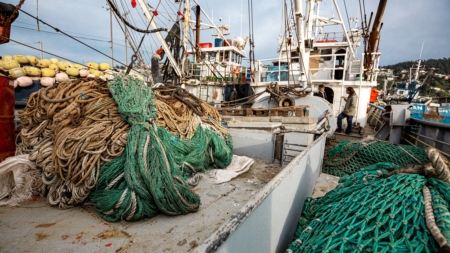Net Positive
How discarded plastic fishing nets found their way into our hat brims.
Every year, over eight million metric tons of plastic trash washes into the sea. Plastic has been found in the bellies of beached whales and migrating albatross. It’s been discovered in deep-sea sediment and Arctic ice cores. According to a 2017 UN report, there are more than 51 trillion microplastic particles in the sea, more than 500 times the number of stars in the Milky Way. The most harmful ocean plastic offender is discarded fishing gear.
For generations, old, frayed and torn fishing nets have been thrown away at the end of their life. Discarded nets now make up 10 percent of the global marine plastics by volume. But it turns out that these nets can be repurposed in all kinds of ways.
“Nets may last between two to three years, depending on how they’re used,” says Kevin Ahearn, co-owner of Bureo, a Tin Shed Ventures partner company. “But there’s still a lot of value in that material even when a net is at the end of its life.” In 2012, Kevin, along with friends Ben Kneppers and David Stover, started thinking about ways to harvest that value and, in the process, reduce the amount of plastics in the ocean.
In 2013, with the help of a grant from the Chilean government, the three friends set up shop in Chile, aiming to turn the nets into skateboards. They named their business Bureo, a commonly used Mapuche word for wave, and began canvassing fishermen for worn-out nets. They stored their haul in a rented warehouse, cleaned the nets by hand, shredded them, and contracted local recyclers to melt them down into “nurdles”: small pellets used as a raw material in plastic products. They branded their material NetPlus®, and within a year launched their first skateboard. A second board followed, but sales and manufacturing couldn’t keep pace with the volume of nets that showed up on their doorstep.
With more material than retail know-how, Bureo pivoted from making their own products to partnering with established brands, and in 2016, Patagonia began working with them to replace the virgin plastic used in the brims of our trucker hats.
At the time, NetPlus® was made almost exclusively from the nylon nets that dominate both the Chilean and global fishing industries, but it kept breaking our sewing needles. Fortunately, South American fishermen also occasionally use high-density polyethylene (HDPE) nets, the same polymer we normally use to make our brims. When Bureo also started making NetPlus® from HDPE nets, our needles were spared.
So Ben, who is based in South America, flew to Mar del Plata, Argentina’s main fishing port, and made a deal with Moscuzza, a local net manufacturer. According to the terms they reached, every old Moscuzza net will be collected by Bureo in return for payments to fishing communities, creating both infrastructure and incentive to give these nets a second life. Since then, Bureo has struck similar deals with both nylon and HDPE net manufacturers in more than 25 Chilean fisheries, and they’re working with manufacturers that supply a dozen Peruvian fishing communities as well.
Viewing the waste stream as a new source of raw materials is what circular economics is all about, but very few industries operate that way. “People discard things because there’s no value tied to it,” says Ben. “When you can connect something with value, it’s no longer seen as waste.”
Watch A Net Plus to see how Bureo locked arms with Patagonia to keep 71,000 pounds of discarded fishing net waste out of the ocean each year by putting it into our hat brims.

